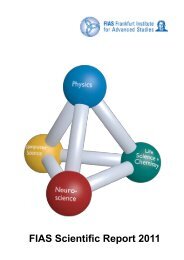FIAS Scientific Report 2010 - Frankfurt Institute for Advanced Studies ...
FIAS Scientific Report 2010 - Frankfurt Institute for Advanced Studies ...
FIAS Scientific Report 2010 - Frankfurt Institute for Advanced Studies ...
You also want an ePaper? Increase the reach of your titles
YUMPU automatically turns print PDFs into web optimized ePapers that Google loves.
4. Project “IM-CLeVeR”: Intrinsically Motivated Cumulative Learning Versatile<br />
Robots<br />
Collaborators: C. Dimitrakakis 1 , L. Lonini 1 , C. A. Rothkopf 1 , J. Triesch 1 , R. Pramod 1<br />
1 <strong>Frankfurt</strong> <strong>Institute</strong> <strong>for</strong> <strong>Advanced</strong> <strong>Studies</strong><br />
IM-CLeVeR is an integrated project (IP) funded by the European Union and involves partners from multiple<br />
European countries. The overall goal of the project is to better understand:<br />
– The development of intrinsic motivation mechanisms <strong>for</strong> driving exploration and autonomous development.<br />
– Cumulative learning of multiple skills, through the efficient building of new skills by reusing or refining old<br />
skills.<br />
IM-CLeVeR brings together Neuroscientists, Psychologists, Roboticists, and machine learning experts to tackle<br />
these problems. There are diverse research ef<strong>for</strong>ts around these core areas, including exploration and exploitation<br />
trade-offs, optimal planning, efficient representations, novelty detection and hierarchical world models, to<br />
name but a few.<br />
At <strong>FIAS</strong>, the research focuses in the following main areas:<br />
1. Applied vision research. Using a mobile robot head, efficient algorithms <strong>for</strong> perceptual abstraction, object<br />
recognition, tracking and autonomous learning are investigated. This ef<strong>for</strong>t also lays the groundwork <strong>for</strong><br />
models developed in other parts of the research to be implemented in the robot itself.<br />
2. Hierarchical models <strong>for</strong> rein<strong>for</strong>cement learning, estimation and control. Complex inference and planning<br />
problems can be more easily managed in a hierarchical framework. A number of statistical techniques<br />
are investigated <strong>for</strong> efficient and accurate learning and planning.<br />
3. Links between utility theory and apprenticeship learning. Apprenticeship learning is a potentially important<br />
learning mode. The objective is not only to imitate what a demonstrator is doing, but to furthermore<br />
infer what he is doing and improve upon it.<br />
4. Links between models and animal learning. Investigate whether models exhibit emergent behaviour<br />
reminiscent of animal learning, then design experiments to test this hypothesis.<br />
5. Near-optimal Bayesian planning. Since Bayesian planning is intractable, investigate efficient approximate<br />
algorithms that do as well as possible given a computational budget.<br />
6. Utility theory models <strong>for</strong> curiosity. Characterise the value of in<strong>for</strong>mation in an abstract classes of tasks,<br />
thus obtaining a well-defined measure of curiosity. Derive approximate, but nearly optimal, “curiositybased”<br />
algorithms based on this measure.<br />
Related publications in <strong>2010</strong>:<br />
1) A. Alessi, L. Zollo, L. Lonini, R. De Falco, E. Guglielmelli, Incremental learning control of the DLR-HIT-<br />
Hand II during interaction tasks, Engineering in Medicine and Biology Society (EMBC), <strong>2010</strong> Annual<br />
International Conference of the IEEE. pp.3194–3197.<br />
17

















